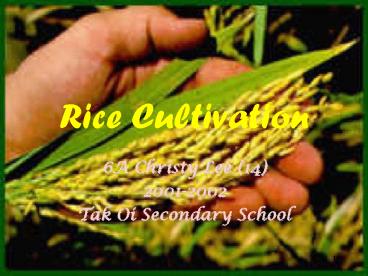Rice Cultivation - PowerPoint PPT Presentation
1 / 19
Title:
Rice Cultivation
Description:
... E India (Bay of Bengal), SE Asian lowlands ... done by hand or with the help of water buffalo. ... plant needs lots of moisture as it grows in standing water. ... – PowerPoint PPT presentation
Number of Views:2092
Avg rating:5.0/5.0
Title: Rice Cultivation
1
Rice Cultivation
- 6A Christy Lee (14)
- 2001-2002
- Tak Oi Secondary School
2
World Distribution
3
Characteristics
- Intensive Subsistence Farming
- e.g. SE China, E India (Bay of Bengal), SE
Asian lowlands - Farms are small, often 1 hectare, or even less.
- Labour is intensive. It takes 2000 hours per year
to farm each 1 hectare plot. - There is little use of machinery. Most tasks are
done by hand or with the help of water buffalo.
Their manure is used as fuel rather than
fertilizer.
4
- Many farmers now use new hybrid rice varieties
which give high yields. - Fertilizers are used in areas where Green
Revolution crops are grown. - Some capital input is required for new seed types
and fertilizer. - Farmers are often tenants. They pay their rent in
crops (sharecroppers).
5
Case Study Wet Rice Cultivation in China
- In the more remote parts of China, e.g. Hunan,
Jiangxi, Anhui, inland parts of Fujian and
Zhejiang, inland/ mountain parts of Guangdong,
Guangxi, Guizhou - Monsoon climate
- Double-cropping is common.
6
Case Study Wet Rice Cultivation in China
- Farmers terrace the hillsides of river valleys to
produce more flat land. - The same fields are planted every year.
- Livestock are usually not allowed to graze on the
land that can be used for crops. - Little grain is planted for animal feed.
7
Rice Cultivation An Economic System
- Physical Inputs
- Monsoon Climate
- - Warm dry winters, hot wet summers
- - Annual Rainfall exceed 2000 mm
- - Temperature Range over 25C
- Soil Oxisols
- Relief Flat land, from lowland paddy fields to
high altitude terraces - Natural Vegetation Grassland
8
Rice Cultivation An Economic System
- Cultural Inputs
- Demand Large, for self consumption
- Labour Tenants
- Managerial Staff No
- Technological Level Low
- Mechanization Level Low
9
- Government Influence Under the Responsibility
System of 1979, individual farmers were given
rent-free land in their own village or district.
They had to take out contracts with the
government to deliver a fixed amount of produce.
Once they had fulfilled their quotas, they could
sell the remainder on the open market for profit. - Personal Preference Land is passed down from
father to son, resulting in fragmented plots.
10
Rice Cultivation An Economic System
11
Rice Cultivation An Ecological System
- Biotic Components
- Producer Rice
- Primary Consumer Man, Grasshoppers, Insects
- Abiotic Components
- Solar Energy, Rainfall, Soil
- Small dose of fertilizers pesticides
12
Rice Cultivation An Ecological System
Energy flow Solar energy ? rice ? man
Nutrient cycle
13
Farming Efficiency
- a. Ecologically Speaking
- As compared with mixed agriculture,
rice cultivation is more ecologically efficient
as the energy goes through one less trophic
level. - In addition, it is more ecologically
efficient compared with commercial agriculture,
as it involves little additional energy input.
14
Farming Efficiency
- b. Economically Speaking
- Economically speaking, rice cultivation
is not very efficient. Farming produce is
basically for self consumption, with little taken
out for market.
15
Selection of Crop
- a. Ecological Considerations
- This kind of tropical grass-plant needs
lots of moisture as it grows in standing water.
Monsoon climate brings about heavy rainfall which
favours the growth of rice. - b. Economic Considerations
- More than 50 of Chinas population
eat rice as its staple food. In other words, it
has to support a large population.
16
Selection of Production Method
- Ecological Considerations
- Double-cropping is common where winters
are warm, e.g. South China, Taiwan, but not in
India. - The second crop is often a drier crop,
such as wheat or barley.
17
Selection of Production Method
- b. Economic Considerations
- In the tropics, 2 or 3 crops of rice
can be grown per year, bringing the possible
maximum yield from the land.
18
Revision
- Name two countries where wet rice cultivation is
carried out. - What are the climatic requirements for its
growth? - In the tropics, how many crops of rice can be
grown per year?
19
Reference Material
- David Waugh, Geography an Integrated Approach
(Chapter 16) - Websites
- - Rice Straw Management
- - Rice Intensification
- - Is there a future for subsistence agriculture?
- - Farming Systems - Intensive Subsistence































